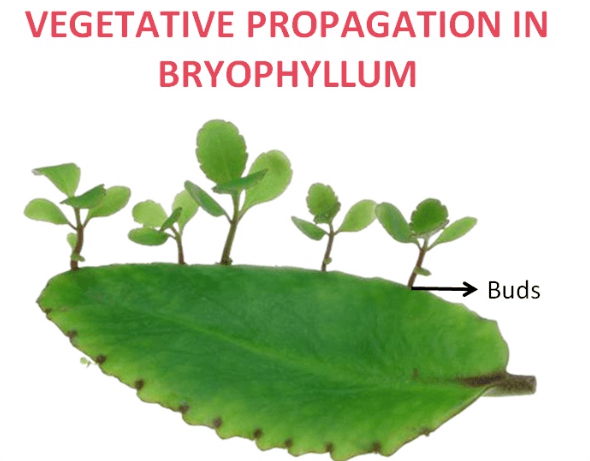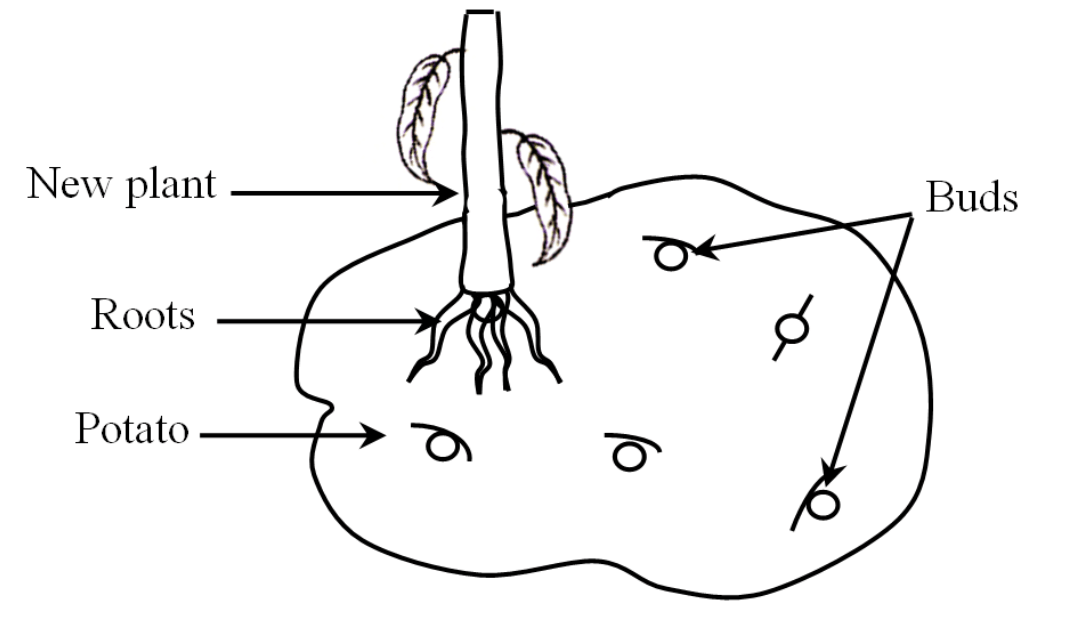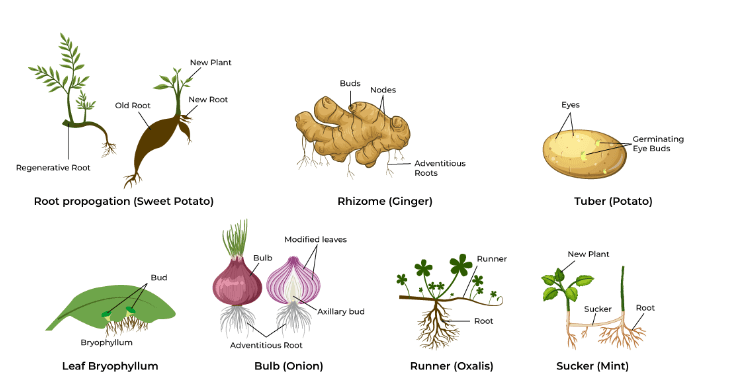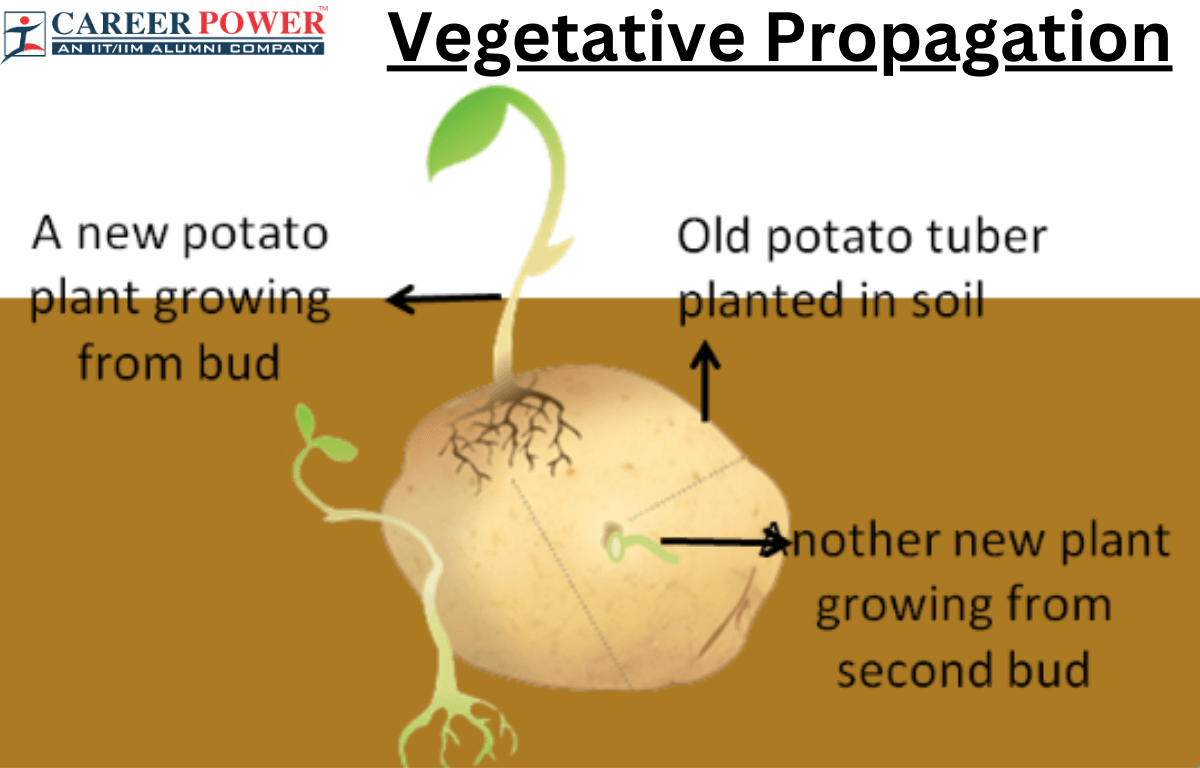As we know asexual reproduction in plants, is commonly known as vegetative propagation. It is also counted as one of the important topics in Biology. It is a simple way for them to create new plants without seeds. Vegetative propagation occurs when a part of the plant, like a stem or a leaf, grows into a whole new plant. This method doesn’t involve seeds or Fertilization, allowing plants to multiply genetically identical offspring quickly.
What is Vegetative Propagation?
Vegetative propagation is a form of Asexual Reproduction in plants where new individuals develop from specialized structures of the parent plant, such as stems, leaves, or roots, without the involvement of seeds. This process allows plants to produce genetically identical offspring, known as clones. Common methods of vegetative propagation include cutting stems, grafting, layering, and division. It is widely used in horticulture and agriculture to propagate plants with desirable traits, ensuring the preservation of specific genetic characteristics. The plants that reproduce through vegetative propagation include strawberries (via runners), potatoes (from tubers), and mint (through rhizomes).

Diagram of Vegetative Propagation
A diagrammatic representation of vegetative propagation typically illustrates how plants can reproduce asexually using various parts of their structure. This diagram visually represents the process of vegetative propagation, where a new plant is created using a part of the parent plant without the involvement of seeds or spores. Here we have mentioned a well-labeled diagram showing the process of vegetative propagation.

Process of Vegetative Propagation
Vegetative propagation is a form of asexual reproduction in plants where new plants develop from existing vegetative structures, such as stems, roots, or leaves, without the involvement of seeds. Here we have discussed a step-by-step explanation of the process. By following these steps, plants can be propagated vegetatively, preserving the genetic characteristics of the parent plant in the new offspring.
Step 1: Selection of Parent Plant:
Choose a healthy and mature plant with desirable traits. This is the existing plant from which vegetative propagation will occur. It represents the source of genetic material.
Step 2: Selection of Propagation Method:
Decide on the method of vegetative propagation you want to use, such as cutting, layering, grafting, or division, based on the plant species and the desired outcome.
Step 3: Preparation of Propagulant:
- Cutting: One common method of vegetative propagation involves taking a cutting from the parent plant’s stem. This cutting, which includes a portion of the stem with nodes and leaves, can develop roots and grow into a new plant.
- Layering: For layering, make a small cut or wound on a stem and encourage it to root while still attached to the parent plant.
- Grafting: In grafting, a scion (a piece of stem with buds) from the desired plant is attached to the rootstock (the rooted part of another plant). This allows the scion to grow using the established root system.
- Division: Some plants can be divided into multiple parts, each with its root system. This method is common for plants like hostas and ornamental grasses.
Step 4: Rooting (For Cutting):
If using stem cutting, dip the cut end in the rooting hormone (optional) to encourage root development. Plant the cutting in a suitable growing medium (soil or soulless mix) and provide adequate moisture and light. Roots will develop from the nodes, establishing a new plant.
Step 5: Rooting (For layering and grafting):
In layering, roots will develop at the wounded areas of the stem while it is still attached to the parent plant. In grafting, the scion will eventually form a union with the rootstock, and roots will grow from the graft site.
Step 6: Transplanting:
As roots form and grow, a new plant starts emerging from the stem cutting, it can be transplanted into its permanent location, whether it’s a garden, pot, or other suitable growing environment. This new plant is genetically identical to the parent plant, as it’s a clone produced through vegetative propagation.
Step 7: Care:
Provide proper care, including watering, sunlight, and nutrients, to support the growth of the newly propagated plant. Monitor its progress and ensure it receives the necessary care for healthy development.
Types of Vegetative Propagation
Vegetative propagation can occur naturally in plants or be induced artificially by humans. Both natural and artificial methods of vegetative propagation have significant agricultural and horticultural applications, allowing for the efficient reproduction of desirable plant traits.
(a). Natural Vegetative Propagation:
- Runners (Stolons)
- Rhizomes
- Tubers
(b). Artificial Vegetative Propagation:
- Cuttings
- Grafting
- Budding
- Layering
Methods of Vegetative Propagation
Vegetative propagation is a method of plant propagation that does not involve the formation of seeds. Here we have given an overview of the common methods of vegetative propagation. Each method has its advantages and is suitable for different types of plants, allowing for the propagation of specific traits or the preservation of unique varieties.
| Methods of Vegetative Propagation | |
| Methods | Description |
| Cutting | In this process, a portion of stems, leaves, or roots, are cut from a parent plant and encouraged to grow into a new plant. |
| Layering | Here a portion of a stem is bent down and covered with soil while the parent plant. After roots develop, it is served and become an independent plant. |
| Grafting | The tissues of two plants are joined so that they grow as a single plant. This method is often used in horticulture to combine desirable traits of different plants. |
| Budding | A bud from one plant is grafted onto another. It involves placing a single piece of bark into a T-shaped cut on the stem of the rootstock plant. |
| Division | Perennials with clumping growth habits can be divided into smaller plants. This is common for plants like hostas and ornamental grasses. |
| Tubers, Rhizomes, and Bulbs | Plants develop specialized underground structures (e.g., potatoes, irises) that can be divided and replanted to grow new plants. |

- Cutting: A part of the stem, root, or leaf is cut from the parent plant and placed in soil or water to develop roots and form a new plant.
- Layering: A portion of a stem is bent down and covered with soil while still attached to the parent plant. Roots develop at the buried part, and the stem is then cut and planted as an independent plant.
- Grafting: A twig or bud from one plant (scion) is attached to a rooted plant (rootstock) of a closely related species. The two parts grow together to form a single plant with the desirable traits of both.
- Budding: Similar to grafting, but instead of a twig, a single bud with a small piece of bark is used. It is inserted into a T-shaped slit in the rootstock’s bark, and after union, the top part of the rootstock is removed.
- Tubers: Swallen underground stems, like potatoes, store nutrients and have buds (eyes) that can sprout into new plants.
- Rhizomes: Horizontal underground stems that grow horizontally and give rise to new shoots and roots at nodes, forming a new plant.
- Bulbs: Underground storage leaves surrounded by modified leaves. When planted, the bulb produces new shoots and roots, growing into a new plant.
- Corms: Similar to bulbs but composed of solid tissue without fleshy leaves. Corms also have nodes from which new plants can develop.
- Suckers: Adventitious shoots that arise from the base of the parent plant, often forming a cluster around the parent plant. They can be separated and planted as individual plants.
- Offsets: Small shoots that develop at the base of the parent plant. These offsets can be separated and planted independently to grow into new plants.
Disadvantages of Vegetative Propagation
While vegetative propagation offers several advantages, such as preserving desirable traits and enabling rapid multiplication of plants, it also comes with certain disadvantages. These disadvantages will highlight the limitations of vegetative propagation.
- Clones lack genetic diversity, making them vulnerable to diseases.
- All plants in a clone are susceptible to the same pests and diseases.
- Clonal populations struggle to adapt to changing environments due to genetic uniformity.
- A continuous supply of healthy parent plants is essential; the loss of the parent disrupts propagation.
- Some methods require skilled labor, making propagation labor-intensive and costly.
- Genetic diversity is limited, hindering traditional breeding methods for improvement.



 50 Vegetables Name for Kids in English a...
50 Vegetables Name for Kids in English a...
 Food Chain: Definition, Types, Examples,...
Food Chain: Definition, Types, Examples,...
 Human Respiratory System: Definition, Di...
Human Respiratory System: Definition, Di...













